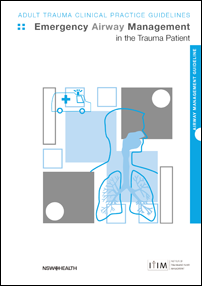Published: January 2007. Next review: 2023.
Hypoxia and airway compromise are recognised to be significant contributing factors in up to 34% of deaths pre-hospital. Early recognition and appropriate management of the injured patient’s airway and ventilation will avoid preventable deaths from airway problems after trauma.

This guideline is intended for use by all clinicians involved in airway management of adult trauma patients presenting to the emergency department. It present practical, evidence-based guidelines for airway management in common scenarios of trauma resuscitation.
The guideline includes algorithms, summary, discussions, tables of evidence, appendices and references.
Author: Dr Joe Ollerton, Trauma Fellow, Liverpool Hospital
Download the guideline (PDF 1.3 MB)
Supporting resources
These are extracts from the guideline.
Summary guideline (PDF 1.1 MB) – contains algorithms and guidelines.
Algorithm 1 (PDF 512.1 KB) – A3 colour algorithm of standard airway management.
Algorithm 2 (PDF 453.9 KB) – A3 colour algorithm of difficult airway management.
Clinical questions
The development of the guideline was based on assessing these clinical questions.
- In the patient with potential cervical spine injury requiring emergency intubation in the resuscitation room, what is the optimal method of achieving a secure airway?
- In adults with severe head injury (Glasgow Coma Score ≤8) undergoing emergency intubation in the emergency department, what are the optimal induction agents to minimise secondary brain injury?
- In hypotensive trauma adults requiring emergency intubation in the emergency department, what is the optimal induction technique to minimise further haemodynamic instability?
- In the trauma adult requiring emergency control of the airway, what is the best treatment algorithm to follow for management of a 'difficult airway'?